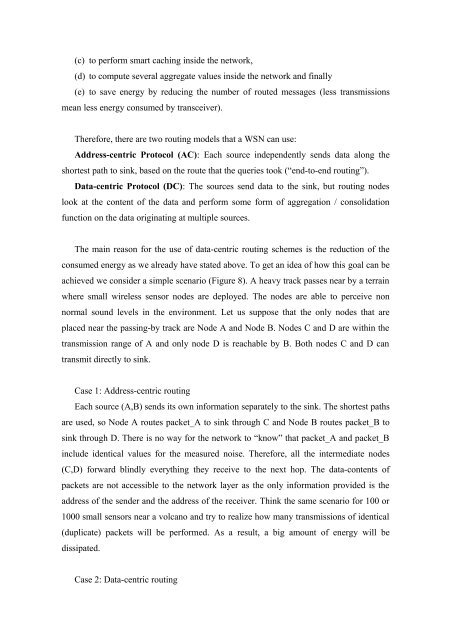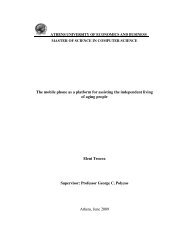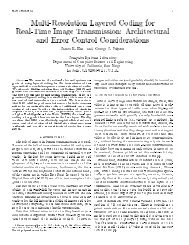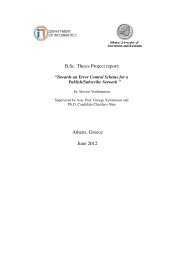In Network Processing and Data Aggregation in
In Network Processing and Data Aggregation in
In Network Processing and Data Aggregation in
You also want an ePaper? Increase the reach of your titles
YUMPU automatically turns print PDFs into web optimized ePapers that Google loves.
(c) to perform smart cach<strong>in</strong>g <strong>in</strong>side the network,(d) to compute several aggregate values <strong>in</strong>side the network <strong>and</strong> f<strong>in</strong>ally(e) to save energy by reduc<strong>in</strong>g the number of routed messages (less transmissionsmean less energy consumed by transceiver).Therefore, there are two rout<strong>in</strong>g models that a WSN can use:Address-centric Protocol (AC): Each source <strong>in</strong>dependently sends data along theshortest path to s<strong>in</strong>k, based on the route that the queries took (“end-to-end rout<strong>in</strong>g”).<strong>Data</strong>-centric Protocol (DC): The sources send data to the s<strong>in</strong>k, but rout<strong>in</strong>g nodeslook at the content of the data <strong>and</strong> perform some form of aggregation / consolidationfunction on the data orig<strong>in</strong>at<strong>in</strong>g at multiple sources.The ma<strong>in</strong> reason for the use of data-centric rout<strong>in</strong>g schemes is the reduction of theconsumed energy as we already have stated above. To get an idea of how this goal can beachieved we consider a simple scenario (Figure 8). A heavy track passes near by a terra<strong>in</strong>where small wireless sensor nodes are deployed. The nodes are able to perceive nonnormal sound levels <strong>in</strong> the environment. Let us suppose that the only nodes that areplaced near the pass<strong>in</strong>g-by track are Node A <strong>and</strong> Node B. Nodes C <strong>and</strong> D are with<strong>in</strong> thetransmission range of A <strong>and</strong> only node D is reachable by B. Both nodes C <strong>and</strong> D cantransmit directly to s<strong>in</strong>k.Case 1: Address-centric rout<strong>in</strong>gEach source (A,B) sends its own <strong>in</strong>formation separately to the s<strong>in</strong>k. The shortest pathsare used, so Node A routes packet_A to s<strong>in</strong>k through C <strong>and</strong> Node B routes packet_B tos<strong>in</strong>k through D. There is no way for the network to “know” that packet_A <strong>and</strong> packet_B<strong>in</strong>clude identical values for the measured noise. Therefore, all the <strong>in</strong>termediate nodes(C,D) forward bl<strong>in</strong>dly everyth<strong>in</strong>g they receive to the next hop. The data-contents ofpackets are not accessible to the network layer as the only <strong>in</strong>formation provided is theaddress of the sender <strong>and</strong> the address of the receiver. Th<strong>in</strong>k the same scenario for 100 or1000 small sensors near a volcano <strong>and</strong> try to realize how many transmissions of identical(duplicate) packets will be performed. As a result, a big amount of energy will bedissipated.Case 2: <strong>Data</strong>-centric rout<strong>in</strong>g








